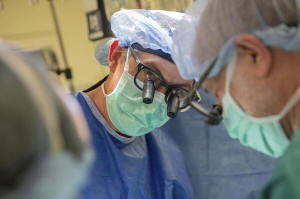Researchers try new ways of preserving more hearts for transplants
[July 17, 2025]
By LAURAN NEERGAARD
WASHINGTON (AP) — Two university hospitals are pioneering new ways to
expand lifesaving heart transplants for adults and babies — advances
that could help recover would-be heart donations that too often go
unused.
The new research aims to overcome barriers for using organs from someone
who dies when their heart stops. Called DCD, or donation after
circulatory death, it involves a controversial recovery technique or the
use of expensive machines.
Surgeons at Duke and Vanderbilt universities reported Wednesday that
they’ve separately devised simpler approaches to retrieve those hearts.
In the New England Journal of Medicine, they described successfully
transplanting hearts to a 3-month-old infant at Duke and three men at
Vanderbilt.
“These DCD hearts work just as well as hearts from brain-dead donors,”
said Vanderbilt lead author Dr. Aaron M. Williams.
How hearts are saved for donation
Most transplanted hearts come from donors who are brain dead. In those
situations, the body is left on a ventilator that keeps the heart
beating until the organs are removed.
Circulatory death occurs when someone has a nonsurvivable brain injury
but because all brain function hasn’t ceased, the family decides to
withdraw life support and the heart stops. That means organs can spend a
while without oxygen before being recovered, a time lag usually doable
for kidneys and other organs but that can raise questions about the
quality of hearts.
To counter damage and determine whether DCD organs are usable, surgeons
can pump blood and oxygen to the deceased donor’s abdominal and chest
organs — after clamping off access to the brain. But it’s ethically
controversial to artificially restore circulation even temporarily and
some hospitals prohibit that technique, called normothermic regional
perfusion, or NRP.

Another option is to “reanimate” DCD organs in a machine that pumps
blood and nutrients on the way to the transplant hospital. The machines
are expensive and complex, and Duke’s Dr. Joseph Turek said the devices
can’t be used for young children’s small hearts — the age group with the
most dire need.
New ways of preserving hearts
Turek’s team found a middle ground: Remove the heart and attach some
tubes of oxygen and blood to briefly assess its ability to function —
not in a machine but on a sterile table in the operating room.
They practiced with piglets. Then came the real test. At another
hospital, life support was about to be withdrawn from a 1-month-old
whose family wanted to donate — and who would be a good match for a
3-month-old Duke patient in desperate need of a new heart. The other
hospital didn’t allow the controversial NRP recovery technique but let
Turek’s team test the experimental alternative.
[to top of second column]
|

This photo provided by DukeHealth shows surgeon Joseph Turek during
pediatric heart surgery in Durham, N.C., in 2021 (Shawn Rocco/DukeHealth
via AP)
 It took just five minutes to tell
“the coronary arteries are filling well, it’s pink, it’s beating,”
Turek said. The team promptly put the little heart on ice and raced
it back to Duke.
Vanderbilt’s system is even simpler: Infuse the heart with a
nutrient-rich, cold preservative solution before removing it from
the donor’s body, similar to how hearts from brain-dead donors are
handled.
That “replenishes the nutrients that are depleted during the dying
process and helps protect it for transport,” Williams explained,
adding that Vanderbilt has performed about 25 such transplants so
far. “Our view is you don’t necessarily need to reanimate the
heart.”
More donated hearts are needed
There's a huge need for more transplantable hearts. Hundreds of
thousands of adults suffer from advanced heart failure, yet many are
never even offered a transplant because of the organ shortage.
Every year about 700 children in the U.S. are added to the
transplant list for a new heart and about 20% die waiting. Turek
said infants are at particular risk.
Last year, people whose lives ended via circulatory death made up
43% of the nation’s deceased donors — but just 793 of the 4,572
heart transplants.
That's why many specialists say finding ways to use more of those
hearts is crucial. The new studies are small and early-stage but
promising, said Brendan Parent of NYU Langone Health, who directs
transplant ethics and policy research.
“Innovation to find ways to recover organs successfully after
circulatory death are essential for reducing the organ shortage,” he
said.
If alternatives pan out, “I absolutely think that cardiac programs
will be thrilled, especially at hospitals that have rejected NRP.”
All contents © copyright 2025 Associated Press. All rights reserved
 |